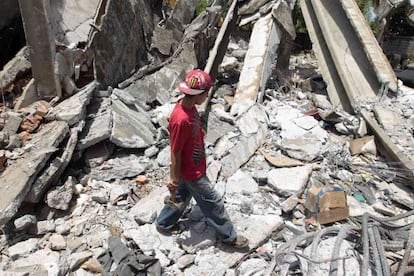Nicaragua issues red alert after earthquakes shake the capital
Seismic activity may be from first major crustal plate movements since 1972’s devastating quake

The Nicaraguan government has placed the country on maximum alert after a series of earthquakes shook Managua and other outlying areas over a five-day period. The latest emergency occurred early Monday morning when a 5.6-magnitude quake destroyed at least seven houses in Managua, Reuters reported.
Two other tremors, measuring 6.2 and 6.6, rocked central Nicaragua on Thursday.
“We are not trying to cause any panic,” said Nicaragua’s first lady Rosario Murillo in a televised address on Sunday. “We don’t want anyone to lose their composure but we need to make people aware that we are under special circumstances that need attention.”
Murillo said that the two quakes last week may have been triggered by seismic activity from the Cocos and Caribbean plates, which intersect near Managua. Many Nicaraguans remember the devastating 1972 earthquake that destroyed much of the capital and left more than 10,000 people dead and 20,000 injured.
At least one person was reported dead and 33 injured from last Thursday’s quake. Panic spread across Managua forcing hundreds of residents to flee their homes. A series of powerful aftershocks followed by another quake also rocked the region but didn’t cause any major damage, authorities said.
“We are not trying to cause any panic”
Seismologists believe that this is the first time in 41 years that there have been major movements of the two crustal plates, Murillo said.
As part of the emergency, the government of President Daniel Ortega has asked Managua residents to sleep in open spaces, such as parks, gardens, porches and patios, and try not to spend a lot of time indoors. It also urged citizens to stock up on bottled water and canned goods.
Electrical power was temporarily cut off in some areas of the Nicaraguan capital after Thursday’s earthquake. The panic and chaos sparked by last week’s emergency demonstrated that officials are not readily prepared to deal with a major disaster such as the one that occurred in 1972 during the final years of the Somoza family’s control of Nicaragua.
“There could be a powerful aftershock,” said Wilfried Strauch, director of seismology at the Nicaraguan Institute of Territorial Studies (Ineter). He explained that tremors could cause a major eruption from the Momotombo Volcano, which is located just on the edge of the country’s massive Managua Lake near the capital. The 1,297-meter volcano is part of a network of 12 volcanoes located on the Pacific coast of the country.
Tu suscripción se está usando en otro dispositivo
¿Quieres añadir otro usuario a tu suscripción?
Si continúas leyendo en este dispositivo, no se podrá leer en el otro.
FlechaTu suscripción se está usando en otro dispositivo y solo puedes acceder a EL PAÍS desde un dispositivo a la vez.
Si quieres compartir tu cuenta, cambia tu suscripción a la modalidad Premium, así podrás añadir otro usuario. Cada uno accederá con su propia cuenta de email, lo que os permitirá personalizar vuestra experiencia en EL PAÍS.
¿Tienes una suscripción de empresa? Accede aquí para contratar más cuentas.
En el caso de no saber quién está usando tu cuenta, te recomendamos cambiar tu contraseña aquí.
Si decides continuar compartiendo tu cuenta, este mensaje se mostrará en tu dispositivo y en el de la otra persona que está usando tu cuenta de forma indefinida, afectando a tu experiencia de lectura. Puedes consultar aquí los términos y condiciones de la suscripción digital.
Últimas noticias
Tiger Woods turns 50: Will he continue playing on the PGA Tour or take a back seat?
The surreal journey of James Nnaji, the Barcelona youth player selected in the NBA Draft who ended up in the NCAA
Trump claims peace in Ukraine is near, but Moscow suggests otherwise
A survivor’s account of the Interoceanic Train accident: ‘We were scared because of the speed on the curve’
Most viewed
- Oona Chaplin: ‘I told James Cameron that I was living in a treehouse and starting a permaculture project with a friend’
- Reinhard Genzel, Nobel laureate in physics: ‘One-minute videos will never give you the truth’
- Why the price of coffee has skyrocketed: from Brazilian plantations to specialty coffee houses
- Pablo Escobar’s hippos: A serious environmental problem, 40 years on
- Chevy Chase, the beloved comedian who was a monster off camera: ‘Not everyone hated him, just the people who’ve worked with him’








































